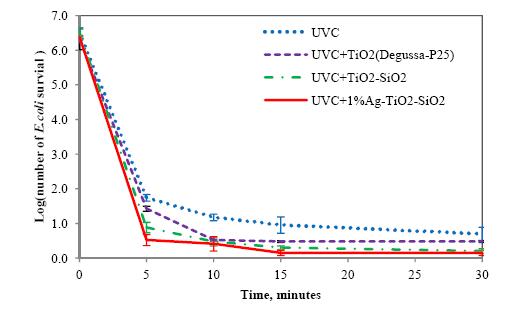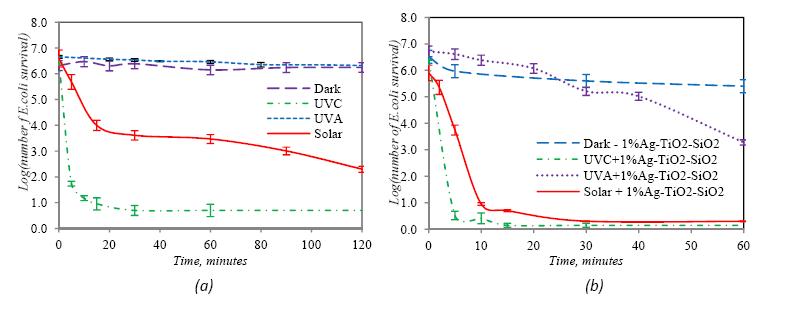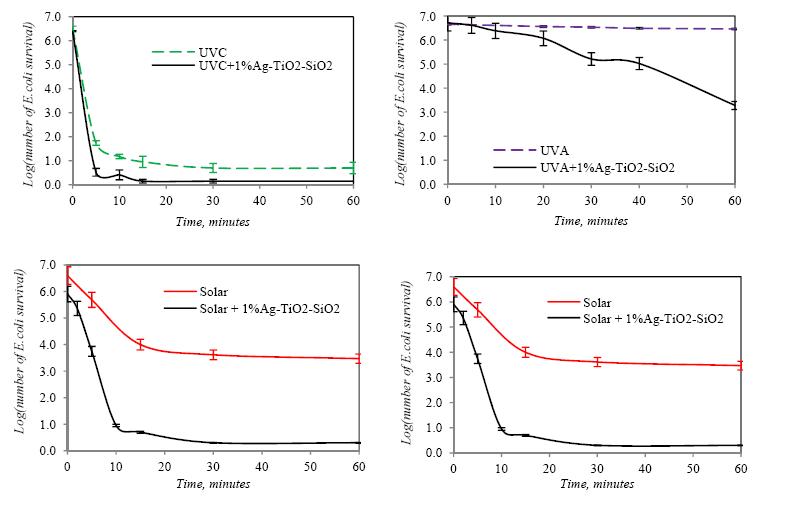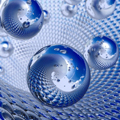1. Introduction
Nowadays, photocatalysis is concerned as one of novel methods in provision of clean drinking water. Among various metal-oxide materials (TiO2, ZnO, SnO2, CeO2 e.g.) being developed for photocatalytic applications, titanium dioxide (TiO2), a semiconductor photocatalyst, has been widely used because it is relatively efficient, cheap, non-toxic, chemically and biologically inert, and high reactivity under UV light irradiation (λ < 390 nm) . When anatase TiO2 is exposed to UV light, holes (hvb+) and excited electrons (ecb-) are generated. The holes are trapped by water (H2O) or hydroxyl groups (OH-) adsorbed on the surface to generate hydroxyl radicals (OH*) [1,2] which are a powerful and indiscriminate oxidizing agents for bactericidal disinfection [3].
However, due to the wide band gap of the TiO2 (~3.2 eV), it can only be applied in the UV irradiation which was ~5% of the solar energy, while the visible light contains about 45% of the solar energy. Therefore, to overcome this difficulty, many studies have been done to investigate the deposition of transition metal ions, i.e. Pt, Au, Pd, Ni, Cu, and Ag ions, into TiO2 as electron acceptors. The results showed that this is an effective way to improve the TiO2 photocatalytic activity under UV irradiation [4,5,6,7] and to improve its visible light sensitivity [8]. Among these ions, Ag+ is getting more attention than others because of its capability: (1) to bind, damage, and alter the functionalities of bacterial cell wall membrane, which are slightly negative [9,10,11,12]; (2) to interact with the thiol groups of proteins that are important for the bacterial respiration and the transport of significant substances through the cell [13]; and (3) to activate visible light excitation of TiO2 [14]. As a result, Ag doped TiO2 highly improved photocatalytic inactivation of bacteria [15,16]. In addition, it is generally believed that Ag nanoparticles enhances photoactivity of TiO2 by lowering the recombination rate of its photo-excited charge carriers and/or providing more surface area for adsorption [17].
Besides doping Ag+ into TiO2 to increase disinfection efficiency, mixing SiO2 with TiO2 to increase the specific surface area of the TiO2 photocatalyst was also studied in another previous study [18]. A high specific surface area can provide more reactive sites for silver deposition and photocatalytic reactions, which is beneficial to the effective disinfection.
From the aforementioned reasons, the combination of Ag, TiO2 and SiO2 in one material shows great promise as efficient and visible lightresponse photocatalytic materials in future. Therefore, in this work, Ag and SiO2 was doped in TiO2 by a sol-gel process to determine their disinfection activities against Escherichia coli bacteria under UV, solar light irradiations and in dark condition, which was then compared to the corresponding activities of the gel-derived TiO2-SiO2 and the commercial TiO2 Degussa-P25.
2. Material and Method
2.1. Chemical reagents
Tetra-iso propyl orthotitanate (TTIP, Merck, Germany), Tetra-ethylorthosilicate (TEOS, 98%, Merck, Germany), nitric acid (Merck, Germany) and silver nitrate (AgNO3, Xilong, China)were selected for the preparation of gel-derived Ag-TiO2-SiO2 nanomaterials. Ethanol (Prolabo, France) and iso-propanol (Prolabo, France) were used as solvents in sol-gel method. Tryptic soy agar (TSA,Indian) was used as growth medium for Escherichia coli(E.coli, ATCC®25922).
2.2. Synthesis of Ag-TiO2-SiO2 catalysts
The detailed preparation procedures of gel-derived Ag-TiO2-SiO2 nanomaterials (Ag-TiO2-SiO2) are mentioned in our previous study [19]. Briefly, four solutions were prepared: the first solution, S1, was prepared by mixing a mixture of ethanol and iso-propanol (solvent mixture, volume ratio of ethanol and iso-propanol = 1:1) with water and nitric acid; the second one, S2, included the solvent mixture, water, and Tetra-ethylorthosilicate; the third solution, S3, was a mixture of the solvents and tetra-iso propyl orthotitanate (the TiO2:SiO2 weight ratio was controlled at 90:10 [18]); and the last one, S4, included the solvent mixture, water, nitric acid and silver nitrate (mol ratio of silver to TiO2 is 1% [19]). The above solutions were then mixed and refluxed. The obtained sol-gel solution was hydrothermally treated in a lab-made autoclave at 150 °C for 10 h. Solvents were then removed at 50 °C using a vacuum evaporation to collect an aerogel. The aerogel was dried in an oven at 105°C for 2 h and then calcined in static air at 400 °C for 2 h.
2.3. Characterization of catalysts
Crystallinity of catalyst was characterized by using X-ray diffraction (Rikagu, Cu Kα). The catalyst particle size and morphology were obtained by using transmission electron microscopy (TEM, JEM 1400, JEOL, Japan). The BET specific surface area of catalyst was determined by nitrogen adsorption at 77 K using a Chembet 3000. In addition, the mean particle sizes can be calculated by the Scherrer’s equation:
where λ = 0.1541 (nm), β is the half-diffraction angle (rad), θ is the half-peak width (degree), and D is the diameter of the crystalline particle (nm) [20].
2.4. Photocatalytic disinfection of E.coli
Photocatalytic disinfection experiments of Escherichia coli (E.coli, ATCC®25922) was conducted in a reactor containing 300 mL of approximately 106 CFU (colony forming units) E.coli /mL under UV-C (15W, Aqua-Pro), UV-A irradiation (15W, Aqua-Pro), solar light (70 to 120 Klux) and in dark (without light) conditions. The concentration of catalyst used in this study was 0.2 g/L. The reaction solution was well mixed for 10 min by using a magnetic stirrer at approximately 200 rpm before the UV lamp was activated. The distance between the UV lamp and the surface of the bacterial solution was 5 cm. For the photocatalytic experiments under solar light, the reactor was exposed under the sun from 10 am to 12 am. All experiments were stopped after 120 min. The antibacterial activity of the catalyst against E.coli was determined by quantitative evaluation methods. 1 mL of the treated solution was diluted with sodium chloride solution (NaCl 0.9%) to obtain the suitable environment for bacterial colonies. The diluted solution was then spread on tryptic soy agar (TSA) plates and incubated at 37 °C for 24 h before the bacterial colonies were counted. Survival of the bacterial population was calculated using the equation :
Log survival ratio= Log (Nt/N0)
where N0 represented the initial population and Nt represented the population after irradiation time (T). The obtained data were the average value of three parallel runs or the values showing the best fitting for an exponential reduction (independent experiments ± standard error of the mean (S.E.M )).
3. Results and Discussion
3.1. Characterization of nanomaterials
Figure 1 shows the XRD patterns of TiO2-SiO2 and 1% Ag-TiO2-SiO2 nanomaterials, obtained by the sol-gel method. XRD patterns show that both TiO2-SiO2 and 1% Ag-TiO2-SiO2 nanoparticle are detected with anatase (α-TiO2) phase which is the favorable structure than its rutile phase. Anatase with better photocatalytic functional properties was identified as the primary crystalline phase in both samples with the peaks at 2θ of 25.3o, 37.8o, 48.2o, 55.04o, and 62.74o relating to (101), (004), (200), (105), (211), and (204) planes, respectively.
However, there is difference between the patterns of these samples. The order of descending crystallinity is observed from the anatase peaks of two XRD patterns in which TiO2-SiO2 is smaller than Ag doped TiO2-SiO2. XRD pattern of the 1% Ag-TiO2-SiO2 nanomaterials clearly exhibits peaks of the metallic silver at 2q of 38.1o, 44.5o và 64.3o relating to (111), (200) và (220) diffraction peaks, respectively, while XRD pattern of TiO2-SiO2 shows there is no peak corresponding to Ag. The peaks of Ag in Ag-TiO2-SiO2 are not clear since the percentage of silver was too small.
The mean crystalline size of the TiO2-SiO2 and 1% Ag-TiO2-SiO2 nanomaterials were calculated at about 10.02 nm and 11.35 nm, respectively, based on the peak broadening analysis described by Scherrer’s equation for the (101) peak [20]. The crystalline size of Ag-TiO2-SiO2 powder slightly increased as compared with that of TiO2-SiO2. These results indicate that during the drying and calcining process, Ag+ ions were formed on crystal borders or spreading on the surface anatase grains, which led to the increase in the crystallite size of anatase phase [21,22].
It is found that the BET specific surface area of gel-derived TiO2 prepared with sol-gel method and hydrothermal treatment (82.7 m2g−1) was higher than that of commercial TiO2 (P25) 53.1 m2g−1. Since the specific surface area has great effect on the photocatalytic activity of TiO2, combination of SiO2 and TiO2 with the promotion of specific surface area (164.5 m2g−1) has demonstrated better photocatalytic activity than only gel-derived TiO2. The specific surface area of TiO2-SiO2 increased around twofold compared to that of bare TiO2 catalyst. However, when Ag was doped in the TiO2-SiO2 nanomaterials, the specific surface area of obtained Ag-TiO2-SiO2 slightly decreased at 147.3 m2g−1. This result may be ascribed to the contribution of silver on the surface of TiO2-SiO2.
3.2.Photocatalytic antibacterial activity
3.2.1. Disinfection against E.coli bacteria under UV-C irradiation
Figure 2 shows the inactivation of E.coliunder the irradiation of UV-C by using photocatalysts of TiO2 (Degussa-P25), TiO2-SiO2 or 1% Ag-TiO2-SiO2 for 30 min. It is clear that Ag doped TiO2 improved the antibacterial activities against E.coliin terms of inactivation efficiency and rate of reaction. Among three kinds of catalysts (commercial TiO2 (P25), TiO2-SiO2 and 1% Ag-TiO2-SiO2), disinfection efficiency of 1% Ag-TiO2-SiO2 was the highest. In addition, the antibacterial efficiency of 1% Ag-TiO2-SiO2 was much higher than that of UV-C only. It took about 5, 10 and 15 minutes to reach 6-log(10) reduction of bacteria colonies by using Ag-TiO2-SiO2 nanomaterials, TiO2-SiO2, commercial TiO2 (P25), respectively. Meanwhile, 30-minute illumination was required to get 5-log(10) inactivation by using UV-C only. This can be obviously explained that under UV illumination, anatase TiO2 exposed to UV-C light generates energy-rich electron-hole pairs which are able to degrade cell components of microorganisms. Therefore, the antibacterial activity of commercial TiO2(P25) was approximately twice as high as that of UV-C only. On the other hands, SiO2 mixed with TiO2 in sol-gel process was observed to significantly increase the BET specific surface area of the gel-derived TiO2-SiO2 (164.5 m2g−1) as compared to that of commercial TiO2(P25) (53.1 m2g−1). The higher the specific surface area of photocatalyst the higher the exposed area between UV-C light and catalysts. This in turn increases the photo-active sites of the catalyst and therefore, improves its photocatalytic activity. As a consequence, the antibacterial activity of gel-derived TiO2-SiO2 was superior to that of commercial TiO2(P25) under UV-C irradiation.
In this present work, Ag was deliberately added in sol-gel preparation of TiO2-SiO2 nanomaterials to promote the effective disinfection of the obtained catalyst because Ag nanoparticles [23,24] and ions [25] were observed to exhibit a strong antibacterial activity. In addition, Ag has been proved to be able to modify TiO2 by effective promotion the e− - h+ separation, thus enhancing the perfomance of photocatalytic antibacterial activity [14]. As a result, the Ag-TiO2-SiO2 catalyst showed superior photoactivity against E.coli as compared with the gel-derived TiO2-SiO2 counterpart under the same preparation condition.
It is interesting that the rates of reactions were extremely fast in first 5 minutes and there was no significant change in the rate of reactions after 5 minutes (Fig. 2).
3.2.2. Disinfection of Ag-TiO2-SiO2 nanomaterials against E.coli under different irradiations
UV light is a well-known traditional disinfectant. Therefore, the photocatalytic properties of the catalysts were evaluated by conducting inactivation experiments of E.coli bacteria under UV irradiation for 120 minutes and compared to experiments under natural sunlight containing only around 5% of UV light. Based on the observed reduction rate of E.coli colonies in figure 3a, it could be seen that the inactivation efficiency under UV-C irradiation (5-log(10)) was extremely higher than those under UV-A irradiation (53.5%) or in dark (0%). It is evident that dark and UV-A were not sufficient to inactivate the bacteria, also confirmed by the previous studies [26,27]. However, after 120-minute exposure to solar light, 4-log(10) reduction of E.coli population was recorded while the reduction of viable bacteria was up to about 5-log(10) under 30-minute UV-C irradiation.
Silver has long been known to be one of the most effective doping metals to change the intrinsic band structure of TiO2, and consequently, to improve its visible light sensitivity [28,29,30] as well as to increase its photocatalytic activity under UV irradiation [31,32,33]. Accordingly, the synergistic effect of UV/solar light and Ag-TiO2-SiO2 was alsostudied in this present work by adding 0.2 g/L of 1% Ag-TiO2-SiO2 in water artificially contaminated with pure bacterial culture (106 CFU E.coli/mL) (Fig. 3b). As discussed above, UV-C light itself presented the superior disinfection efficiency as compared to other irradiation sources (Fig. 3a). Therefore, a combination of UV-C light with Ag-TiO2-SiO2 definitely performed the highest disinfection efficiency against E.coli as shown in Fig. 3b.
To further clarify the synergistic effect of Ag-TiO2-SiO2 in combination with different light sources, disinfection efficiency of this catalyst against E.coli with and without light irradiation was compared and shown in Fig. 4. The presence of Ag-TiO2-SiO2 under UV-C was not observed to substantially improve the disinfectionefficiency against E.coli of this catalyst (Fig. 4a). Meanwhile, a combination of solar light and Ag-TiO2-SiO2 was found to significantly increase the disinfection efficiency as depicted in Fig. 4c. When exposed under natural sunlight irradiation, only 3-log10 reduction of E.coli was observed while adding Ag-TiO2-SiO2 to the reactor was found to promote the antibacterial activity up to 6-log(10) within 30 minutes. The presence of Ag-TiO2-SiO2 under UV-A was not good as that under solar light. Nevertheless, the synergistic effect of such combination was higher than that of Ag-TiO2-SiO2 under UV-A irradiation. The superior synergistic effect of Ag-TiO2-SiO2 under both UV-A and solar light as compared to that under UV-C counterpart could be ascribed to the red-shift of the absorbance spectrum of the Ag doped TiO2-based catalyst [27]. This catalyst was consequently more photoactive under UV-A and visible light than under UV-C light irradiation. Although the synergistic effect of Ag-TiO2-SiO2 under solar light was superior to that under UV-C, the disinfection efficiency of the latter was observed to be slightly higher than that of the former as shown in Fig. 4a and 4c. These results implied that either UV-C only as a low-cost method or a combination of Ag-TiO2-SiO2 with solar light as an energy-saving method could be efficient to inactivate bacteria.
For the inactivation experiments conducted in dark, the reduction rate of E.coli colonies by Ag-TiO2-SiO2 nanoparticles slightly enhanced (92.4%) after 60 minutes while no change was observed in experiments without catalyst (Fig. 4d). This result could be attributed to: (i) the adsorption of bacteria cells onto TiO2 surfaces; (ii) the antibacterial activity of silver nanoparticles and ions [23,24,25]; (iii) the synergistic effect of Ag and TiO2 in dark [19].
4. Conclusion
A feasible method was proposed to overcome the limitation of TiO2 catalyst in antibacterial activity under sunlight irradiation by preparing the combination of Ag, TiO2 and SiO2 in one material. Ag-TiO2-SiO2 nanoparticle was found to be an effective catalyst in disinfection for water treatment. UV-A had the disinfection capability of 53.5%; however, when combined synergistically with 1% Ag-TiO2-SiO2, the efficiency could increase up to 99.96% in 30 min. In case of doing experiment under UV-C irradiation with Ag-TiO2-SiO2, bacterial could be removed completely within 5 min compared with 30 min under the condition of UV-C without catalyst and 10 min with the experiment of using UV-C-TiO2-SiO2. In the solar light irradiation, the effective reduction of the viable bacteria for the Ag-TiO2-SiO2 was measured 6-log(10) within 30 min. Therefore, Ag-TiO2-SiO2 nanomaterial shows great promise as an efficient and visible light response photocatalytic material in future.
Acknowledgements
This research was supported in part by the HCMC University of Technology and Education and the HCMC Institute for Environmental and Resource.
Conflict of Interest
Authors declare that there is not conflict of interest.










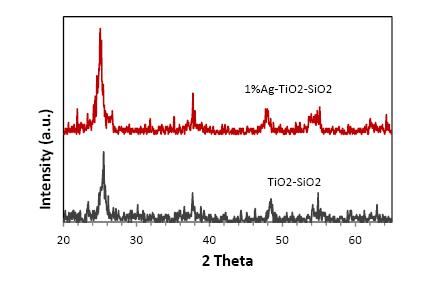
 DownLoad:
DownLoad: 